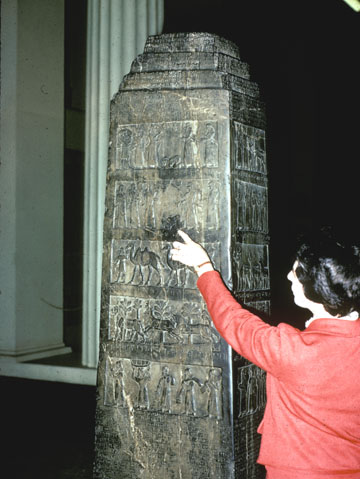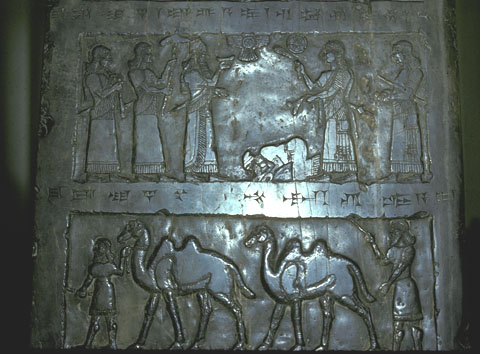Bible Chronology
The Sothic Cycle
In this course I am going to argue for a major alteration of Middle Eastern chronology, but if the only reason for doing so is in order to make history fit the Bible, that would be dishonest. We must not alter facts in order to fit in with our religion and our beliefs. If Christianity and the facts of science or the facts of history do not agree, then we have to alter or abandon our Christian faith.
On the other hand, if there are good historical and archaeological grounds for altering Middle Eastern chronolgy, and if that means that history and the Bible support one another, then from my point of view as a Christian that would be very gratifying. I believe that there are indeed good reasons for altering Middle Eastern chronology, and that is why I have written this course.

| 
| ||
| A friend points to the Jehu panel on the Black Obelisk of Shalmaneser III. | Detail of the Jehu panel. Jehu bows to the ground in front of Shalmaneser. The figure behind Jehu is probably a chamberlain. |
At one time the historical reliability of the Bible was a very respectable position to hold. The discoveries of the early archaeologists all seemed to confirm the Bible: for example, when Henry Layard excavated in Nineveh, one of his discoveries was this black obelisk. He couldn‘t read the writing, but it looked pretty so he brought it back to Britain and it ended up in the British Museum.
A few years later Henry Rawlinson deciphered cuneiform writing and the world was amazed - and delighted - to discover that one of the figures depicted on the Black Obelisk of Shalmaneser III was none other than the Biblical king Jehu, notorious for his fast driving.
However as more and more details have been filled in, it has become apparent that there are problems with Biblical history: it just doesn‘t fit the archaeological evidence. In fact, the problem is so bad that respectable Israeli archaeologists such as Israel Finkelstein have seriously claimed that David and Solomon never existed!
It is remarkable, however, how every time the Bible is seriously attacked, something turns up to confirm it. In this case, just as the denials were gaining ground Abraham Biran, excavating up in the north of Israel at Tel Dan, discovered a stele that mentioned "the house of David". The stele was erected by a Syrian king in the 8th century BC, and it provides such strong independent evidence for the historicity of David that some have actually claimed that the stele is a fraud - a serious slur on the integrity and scholarship of the archaeologist who discovered it.
Right at the heart of all these difficulties is one simple question: when did the Exodus take place? To understand the problem - and, indeed, to understand the solution - we need to talk for a bit about secular chronology.
When we read history books or listen to experts pontificating on radio or television about how Hammurabi lived around 1800 BC or Rameses II around 1280 BC, it is very easy to get the idea that we know these things, that historians and archaeologists have studied the matter and that history rests on a firm foundation. You couldn't be more wrong!
Chronology relies upon written records, which means that when we look at the Middle East there are only a few areas that can provide us with any sort of a chronology: Egypt, with its hieroglyphic records on stone and papyrus; Mesopotamia, with cuneiform records on baked clay tablets; and the Hittites up in northern Turkey, who left rock inscriptions and clay tablets in both cuneiform and their own form of hieroglyphics.
However even if we find all the necessary records, these writings can only give us a relative chronology. We may be able to say that King A ruled for twenty years and his son, King B, ruled for seventeen and the whole dynasty ruled for two hundred and twenty, but that still does not tell us exactly when all these things happened. Did the dynasty rule a thousand years before Christ or two thousand?
There is only one way in which we can get a sure and certain date, and that is from astronomical data. If we can find a clay tablet, for example, that tells us that in the fifth year of Hammurabi, the third day of the tenth month, at ten o‘clock in the morning, there was a total eclipse of the sun, astronomers can work backwards and calculate that that must have been, say, January 27, 2007 BC.
Unfortunately, there was only one ancient civilisation that kept such records with the necessary precision and that was the Assyrians and their neighbours and successors the Babylonians. These records take us back to around 840 BC, no earlier.
At one time it was claimed that although the Egyptians did not record eclipses, it was nonetheless possible to use astronomical data in the form of the Sothic Cycle or the Great Year. According to this theory, the Egyptians recorded the heliacal rising of Sothis and were particularly interested when this coincided with the start of their new year.
As you know, a year is approximately 365.25 days long. That quarter of a day is the reason why, every four years, we have a Leap Year and put in an extra day (February 29). The ancient Egyptians had worked out that the year was 365 days long, but they didn't know about the extra quarter day and as a result they didn't have a Leap Year. This meant that after four years they were a whole day out in their calendars; after eight years they were two days out and so on.
Look at it this way: after four years they were celebrating New Year's Day on what they thought was January 1 but which was really December 31. After another four years New Year's Day fell on December 30, after another four years it was December 29 and so on until after 1,460 years they had lost a full year and New Year's Day once more fell on January 1 - a whole year late!
Just as the moon rises an hour later each day, so the stars rise earlier or later each day, depending on the time of year. Sooner or later - and on the same day each year - every star will rise at more or less the same time as the sun. This is known as "the heliacal rising" of that particular star.
The Egyptians attached great significance to the heliacal rising of the star they called "Sothis". When this happened on the same day as New Year's Day, it was regarded as particularly significant. However because of the facts noted above, the heliacal rising of Sothis only coincided with New Year's Day for four years once every 1,460 years. This period of 1,460 years from one New Year's heliacal rising to the next is called the Sothic Cycle.
In theory, if we know the date in the year on which the heliacal rising of Sothis took place, we can tell to within four years which year it really is. Suppose that we knew that a heliacal rising and New Year's Day coincided in 1000 BC. If we were to find a document saying that the heliacal rising took place two days after New Year's Day, we would be able to say that the document had to be dated to 996-992 BC. (The type of writing, the name of the king, the place where it was found, would all serve to rule out the Sothic Cycles of 2460 BC or 460 AD.
Unfortunately there are several problems with this theory. In the first place, we don‘t know which star is Sothis: astronomers and Egyptologists have speculated that it is Sirius or the Dog Star, but the plain fact is that we simply do not know.
Then there is the problem that we don‘t know in which year the heliacal rising and the new year coincided. A Roman author called Censorinus declared that there had been such an event 100 years before the year in which he was writing, but he dates that year in terms of the Olympiad, the reign of Augustus and the founding of Rome as well as several other eras, which gives a spread of possible years from 143 BC to 264 AD!
| Censorinus dates himself | Date of the event | Therefore date of Censorinus |
| 1040 years of Olpymic era | 776 BC | 264 AD |
| 896 years after founding of Rome | 753 BC | 143 AD |
| 283 years from Parilibus | not known | |
| 986 years from Nabonassar | 746 BC | 240 AD |
| 562 years from Philippi | 347 BC | 205 AD |
| 265 years from Augustus | 28 BC | 237 AD |
| (Taken from The Exodus Problem and its Ramifications by Donovan Courville.) | ||
Finally, we only have one clear Egyptian reference to this "Great Year" as the Sothic Cycle was called, and that comes from nearly the Roman period. There are two other texts that have been interpreted as references to the Great Year but they are vague and unclear.
In short, the Great Year or Sothic Cycle may be nothing more than a clever idea invented by Egyptologists. It is questionable whether it has any value at all in Egyptian chronology.





